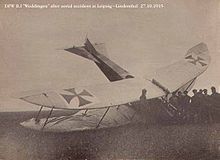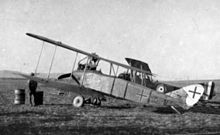German aircraft works
| Deutsche Flugzeug-Werke GmbH (DFW)
|
|
|---|---|
| legal form | Company with limited liability |
| founding | March 1911 (as Sächsische Flugzeug-Werke ) |
| resolution | December 18, 1919 |
| Reason for dissolution | Liquidation as a result of the Versailles Peace Treaty |
| Seat | Lindenthal , Germany |
| management |
|
| Branch | Aircraft manufacturer |
The German aircraft-Werke GmbH , abbreviated DFW , was during the First World War, one of the most important German aircraft manufacturer . They were founded in 1911 in Lindenthal near Leipzig as Sächsische Flugzeug-Werke and later renamed.
history
On April 16, 1911, after the Johannisthal airfield near Berlin, the second-oldest German airfield officially approved for motorized flights opened in Lindenthal . It was located between Lindenthaler Hauptstrasse and An der Hufschmiede south of the old town center (Gartenwinkel). In Lindenthal considerable air sports activities developed in a short time. On October 21 and 22, 1911, the Leipzig Flight Days took place, a competition for long-term and high-altitude flight prices. A biplane from the Sächsische Flugzeugwerke , piloted by Heinrich Oelerich and Hans Schirrmeister, was also used for comparison purposes. Oelerich was a one-flyer and designer for the DFW, later he was a member of the DFW board. On November 2, 1911, he set a long-term flight record of 3 hours 39 minutes on a biplane.
The Sächsische Flugzeug-Werke was founded in March 1911 by the Leipzig publisher Bernhard Meyer and the engineer Erich Thiele . In November 1911, the company was renamed Deutsche Flugzeug-Werke GmbH . DFW had rented three massive aircraft sheds from the Lindenthal Airfield Association for five years, in which the aircraft were assembled. By 1915, assembly halls, an administration building and several houses with company apartments were built on Radefeld's corridor northwest of the Lindenthal fir forest . As a factory airfield , the DFW used the parade ground of the Leipzig garrison located west of the fir forest or the promotional flight events at the Lindenthal airfield.
Erich Thiele opened his own pilot school as early as 1911, at which later well-known pilots such as Franz Büchner , Eugen Wiencziers and Heinrich Oelerich worked as flight instructors. Oelerich first trained future military pilots there in 1912. In 1913, as one of the selected in-house training facilities, the DFW-Fliegerschule was subsidized from funds from the national flight donation and trained up to the field pilot examination.
Under the management of Oskar Schmal, the company initially began producing French prototypes ( Farman ) under license , but began producing its own designs in 1913. The most important designer was the prominent aviation pioneer Heinrich Oelerich.
Bernhard Meyer founded the subsidiary DFW-Flugzeugwerft Lübeck-Travemünde for naval aircraft in 1914 as the sole shareholder . National-Flugzeugwerke (NFW), which emerged from Jeannin -lugzeugbau Johannisthal, took over DFW on June 15, 1915 as a subsidiary. Großzschocher was the new headquarters of NFW , where from 1917 what would later become DFW's Plant II was built in Kaisergrund. A new factory airfield was put into operation on May 11, 1917. A subsidiary was also founded in Austria-Hungary, headed by the designer Heinrich Bier .
Under the direction of the well-known designer Hermann Dorner , the DFW began developing one of the first giant German aircraft in September 1915 , which took off as RI for its first flight just one year later . From 1916, Willi Sabersky-Müssigbrodt led the development of the two-seater CV reconnaissance aircraft to success.
When Bernhard Meyer died on April 19, 1917, his son-in-law Kurt Herrmann became director general of the DFW. After the First World War, the DFW had to cease operations on December 18, 1919 according to the provisions of the Versailles Peace Treaty and go into liquidation. On the initiative of Herrmann, the aircraft factory became the Allgemeine Transportanlagen-Gesellschaft on June 16, 1919 , and DFW GmbH was deleted from the commercial register on June 16, 1928 .
developments
Pre-war models
- DFW biplane , test aircraft
- DFW Mars biplane , trainer aircraft
- DFW racing biplane , sport aircraft
- DFW Stahl-Taube , reconnaissance aircraft
Unarmed reconnaissance / trainer aircraft
- 1914: DFW T 25 , reconnaissance aircraft
- 1914: DFW BI / MD 14, reconnaissance aircraft & trainer aircraft
- 1915: DFW B.II / MRD, trainer aircraft
spotter
- 1915: DFW CI / KD 15, reconnaissance
- 1915: DFW C.II , reconnaissance
- 1916: DFW C.IV , reconnaissance
- 1916: DFW CV / T 29, reconnaissance aircraft
- 1918: DFW C.VI , reconnaissance
- 1918: DFW C.VII / F 37, reconnaissance
Fighter planes
- 1915: DFW T 28 Flea , test fighter plane
- 1916/17: DFW DI , fighter plane
- 1917: DFW Dr.I , Jagddreidecker
- 1918: DFW D.II / F 34, fighter plane
Giant bomber
Others
See also
literature
- Wolfram Sturm: Leipzig goes up in the air. Leipzig aviation from its beginnings to the present. Self publication . Engelsdorfer Verlag, Leipzig 2011, ISBN 978-3-86268-524-0 , pp. 59-63.
- Peter Kühne, Karsten Stölzel: Sachsenflug and fair charter. From the history of aviation in Leipzig and aircraft construction in Saxony. Connewitzer Verlagbuchhandlung, Leipzig 1999, ISBN 3-928833-41-3 , pp. 12-14, 17, 20-23.
- Peter Kühne: Marseindecker and giant aircraft - Deutsche Flugzeugwerke GmbH Leipzig. Publishing house M & M, Martenshagen 2018.
- Günter Kroschel, Helmut Stützer: The German military aircraft 1910–1918. In 127 four-sided tears on a scale of 1: 144. Lohse-Eissing, Wilhelmshaven 1977, ISBN 3-920602-18-8 .
- Enzo Angelucci, Paolo Matricardi: Airplanes. From the beginning to the First World War. Falken-Verlag Sicker, Wiesbaden 1976, ISBN 3-8068-0391-9 .
- Kenneth Munson: Bomber 1914-1919. Orell Füssli Verlag, Zurich (1968).
- Heinz Nowarra: The Development of Airplanes 1914–1918. Munich 1959.




